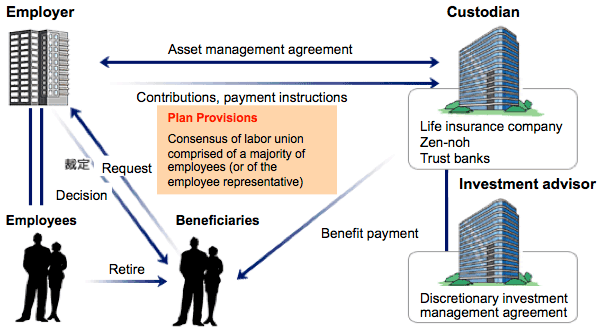
DB Plan
1.Structure
(1) Contract type

(2) Fund (Trust) type

2. Implementation
An employer must obtain approval by Ministry of Labor, Health and Welfare for pension plan provisions drafted with consensus of the union comprising of a majority of workforce or if no union exists, consensus of the employee representative. Such consensus is required at each office, not just at the headquarter.
Size requirement:
More than 300 full-time employees insured by the social welfare pension. (For affiliate group scheme, more than 300 in total of group companies)
No. of plans:
One DB plan per employer except in the following cases:
-Having a single-employer plan and
participating in a multi-employer plan at the same time
-Different work rules apply to different
groups within the company
-Within a year after the merger and acquisition
-Within 5 years after
daiko henjo
-Within 5 years after transferring the rights and obligations from TQPP (until March 31,
2017)
Participants Eligibility:
-The insured person of the Social Welfare Pension
-The
scheme can restrict the eligibility to a certain group* of employees if the restriction is
non-discriminatory and the loss of eligibility is non-discretionary.
*A certain group means the following cases. But an alternative scheme must be in place for (a) and (b) and corporate DC plan or unfunded retirement allowance plan must be in place for (c).
(a) By job category: eligibility can be limited to a certain job category if different employment
conditions such as salary and retirement benefits are applied.
(b) By service period or age:
eligibility can be limited to more than 5 years of service, or more than 30 years of age, or less than
50 years of age.
(c) Those who wish to participate: participation can be voluntary if the loss of
eligibility cannot be chosen at participant's discretion and the continuing stream of new participation
is expected in the future.
Period of Participation
-The following periods can be included in the participant period: a period of service prior to implementation of the plan, a period before acquiring eligibility, service period with another company, period before re-entry (restricted to cases where benefit payments were not made)
3. Benefits
Eligibility for annuity: when a participant reaches a certain age between 60 and 65 or, when a participant retires at age 50 or over and below the age specified above. More than 20 years of participation shall not be set for eligibility requirement.
Annuity period: whole life or fixed term of more than 5 years. If guaranteed period is set, it should be less than 20 years and convertible to lump sum which is equivalent to the present value of annuity for guaranteed period.
Lump sum: provided when eligibility requirement for annuity is not met. Lump sum must be provided after 3 ears of participation at the latest.Survivor's benefit (lump sum or annuity)
Survivor's benefit (lump sum or annuity)
Benefit formula: fixed amount per participant period, final salary or average salary scheme, cash balance plan, or a combination of them are available.
4. Contributions
-Employer must make a contribution regularly more than once a year.
-Contributions must be a fixed
amount or a fixed percentage of salary (or pensionable salary) or a combination of both. They can be set
uniformly or in accordance with gender, age, age at entry.
-Employee contributions are permitted
when the following conditions are met:
(1) Employee contributions are less than 50% of employer contribution
(2) Employee consensus is
obtained.
(3) Employee can opt out.
(4) Once opt out, the employee can no longer contribute
again.
(5)Rules for employee contributions are set forth in the provision.
-Types of contributions
(1) Normal contributions (for future service period)
(2) Special
contributions (for amortization of past service liabilities)
Amortization methods: a. equal
installment (3 to 20 years)
b. flexible (set maximum and minimum installment and
change within the range every year)
c. fixed percentage of balance (more than 15/100
and less than 50/100)
(3) Contributions for amortization of expected deficit (when the assets are
expected to fall short of the minimum funding requirement and actuarial reserve before the next
revaluation date)
(4) Contributions for amortization of deficit (in light of plan termination)
(5) Temporary contributions when the assets become zero and need to pay out benefits.
5. Protection of Vested Rights to the Benefits
In order to protect the beneficiaries' vested benefits, the plan must
(1) Year-end valuation
At the end of the plan year, the plan actuary must conduct the
valuation of funded status based on the following assumptions:
-Plan continuation basis
If assets
< (actuarial reserve minus acceptable deficit), revaluation of contributions
If assets >
maximum funding level, deduction of contributions
-Plan termination basis
If assets < minimum
funding requirement, additional contributions for amortization of deficit
(2) Revaluation
Revaluation must be done at least every 5 years (at a cycle specified
in the provisions) as well as when the number of participants changed drastically or a pan change is
made.